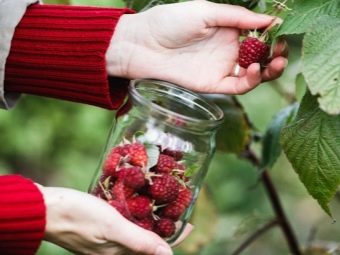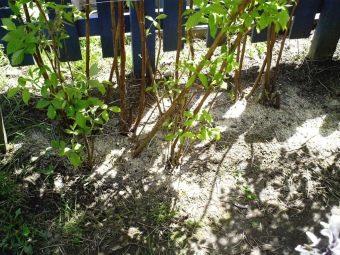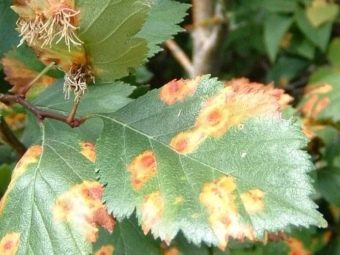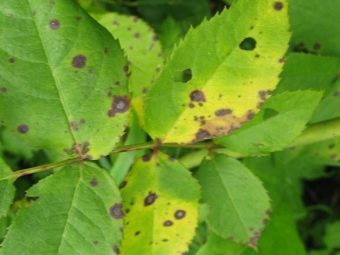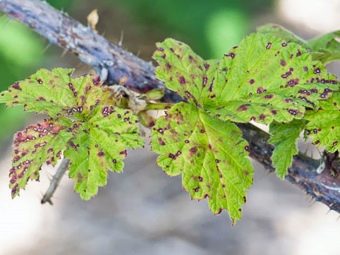Raspberry Heritage: Characteristics and Landing Rules
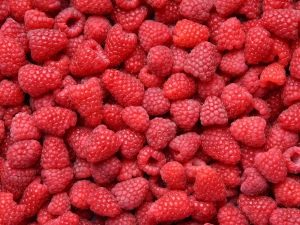
It is always nice to have fruits and berries on your table from your own garden. The most popular types of berries for self-cultivation are strawberries and raspberries. It is recommended to choose from old, already well-studied varieties, whose pros and cons are already known to gardeners. One of these was Raspberry Heritage, first bred in 1969 at New York's Cornell University.
Variety description
Heritage is a remontant variety, which is beautifully grown and has already taken root in many CIS countries, as well as in central and southern Russia. This variety is a hybrid of three popular species: "Milton", "Katberg" and "Durhem". Having shown itself on the positive side, this raspberry also became involved in the cultivation of new varieties of American and European selection. The shrub is not very wide, its height is about two meters. Strong and straight branches covered with a small number of dark thorns.
The main feature of the shoots is their bright red tint, which they acquire in August. The fruits are located in the upper third of the plant and hang on small tassels with a strong base. Despite the very small value of root growth, the shrub multiplies and after two years you can observe new plants. Heritage leaves are small, slightly elongated and have a dark color.
Berries in the form of a shortened cone have an average size and a weight of about three grams. After maturation, they change color to dark maroon, but do not crumble, and hang about five more days.
Delicate and juicy raspberry has a sweet-sour taste and a bright aroma, which is heard from afar. During the tasting, the taste of this variety was rated at 4.6 points on a five-point scale. In the second fruitful year, raspberries begin to sing in the middle of July, and you need to have time to gather it within two weeks. Unfortunately, the yield of the second year is not as good as the first. The following fruits are harvested in September, however, not all berries have time to ripen before the onset of cold weather.
Young bushes bear fruit only once. They are harvested near the end of summer and become mature only with the onset of frosty days. Professional gardeners are advised to grow this variety only annual shoots to the final result was better. Heritage yield with proper care is standard - three kilograms from one bush. If the year was favorable, then successful gardeners collect about six kilograms.
Features and benefits
No wonder the Heritage variety is one of the favorite types, it has a huge number of advantages, in addition to excellent taste. Shoots steadily bear fruit every year, while multiplying. The harvest of berries has a high transportability, which is very important. The fruits do not crumple and do not flow during transportation, so they can be grown for sale, they retain a presentable appearance. Ripe raspberries still hang on the bush for a long time, while it does not lose its shape or taste.
The bushes are frost-resistant and do not die even with severe cold, the main thing is to fertilize them competently. Small growth of overgrowth is also a big plus of the variety, and resistance to various pests increases the durability of plants. However, in addition to the merits, Heritage has some drawbacks. Unfortunately, this variety dies during drought. In case of lack or excess of water, its taste may change and become more acidic.
Another disadvantage is the mandatory installation of trellis to tie up grown bushes.
How to grow?
To get a tasty and juicy raspberry, you should plant it properly and follow the growth of the shrub.
Landing
Raspberry saplings are best purchased at specialty stores or garden fairs from trusted vendors, as some unscrupulous people are tricking into selling other varieties to trusting buyers. The zoned material for planting adapts optimally.To determine the quality it is recommended to pay attention to its escape and root. The thickness of the shoot should not exceed one centimeter and the presence of two already developed shoots is desirable. The minimum length of the root should be fifteen centimeters, a prerequisite is the presence of a large number of small roots.
Planting raspberries of this variety should take place in overcast, but warm weather. It is for this reason that in the southern strip berries are planted in the fall, and in the north - in the spring. Malinnik should be in a well-lit place on the sunny side of the courtyard, since in this place the snow will melt faster in the spring and the earth becomes warmer. It is advisable to distance the raspberry from the source of groundwater and winds. Properly chosen place for planting will be the guarantor of early young shoots and the rapid growth of the bush.
The soil for planting should be fertile and loose, in case of soil depletion, it should be fertilized with manure or wood ash. It is imperative to eliminate all weeds and prepare the landing site in advance. If the seedlings will be planted in the fall, the preparatory work should be carried out in the spring. If a horsetail or horse sorrel is found, the soil should be fertilized with slaked lime or scattered plaster. Such plants are a sign of sour soil.
After carrying out the necessary work begins the process of landing. The first step is to dig holes forty feet deep.
Inside it is recommended to put a little garden soil with fertilizers that will help young cuttings to take root and grow faster.
After planting, the roots should be covered with earth, watered and mulched to maintain the required level of moisture.
Cultivation and care
Heritage shoots should be tied up on pre-installed trellis, which can guarantee a quality crop and prevent wrinkles on the branches from weighted brushes. In this case, each brush will fall under the sunlight.
Watering
In the first year it is recommended to water the bushes often. The following shoots must be regularly fed with moisture only in dry summers. On one bush leaves about two buckets of water during flowering, the appearance of the ovary and berries. The soil should be wet and deep. To preserve the internal moisture is recommended to loosen and mulch the earth.
Pruning
As a rule, in the fall all the shoots are cut. It is not recommended to do this in the summer, as this may harm subsequent crops.
Top dressing
In no case should we forget about the regular fertilization of the soil, since the taste of the fruit depends on it. In the spring, notable gardeners fertilize the soil with manure or humus, and in summer during the flowering and pouring of berries - with ashes, droppings or a mineral complex.
Preparing for the winter
After pruning shoots are only the roots. In case of small precipitations, it is enough to fill the rest of the bush with humus or peat. Be sure to remove the extra branches or dry waste, as they can cause fungus.
Collection and storage
Heritage collection begins at the very end of summer and continues throughout September. Store fresh raspberries recommended for no more than two weeks in the refrigerator. For a long time, the fruit is dried or put in the freezer, because even in this form they retain their beneficial properties. This variety is universal, it can be eaten fresh or can be preserved by preparing a delicious jam or jam.
Most housewives use raspberries and for baking, decorating cakes, as well as additives in ice cream, yogurt and other dairy products.
Disease prevention
Heritage is famous for its resistance to various diseases. However, this does not mean that the variety does not require maintenance work. Shrubs should be constantly fed and thinned, after harvesting the old shoots need to be cut, as well as the affected branches. Substances containing copper in the composition, will favorably affect the quality of the crop.
In case of rainy weather, prophylaxis should be carried out every two weeks.
Raspberry bush diseases
There are several of the most dangerous diseases of any raspberry variety.
- Rust. Orange mounds appear at the end of spring and damage shoots and leaves of shrubs. Because of them, the stems begin to dry up and break down. To prevent this disease, it is recommended that in April the bushes be treated with 3% urea, and immediately before flowering, sprinkle with 1% Bordeaux mixture.
- Spotting. In the case of infection, young foliage begins to become covered with brown spots, after which it dries and falls to the ground. The stems also deteriorate, they dry out and become brittle. Gradually spots begin to cover the whole plant. To prevent this phenomenon, ash is poured around the plant, and in March it is treated with 2% nitragin. Before flowering in this case it is also recommended to spray the shrub with 1% Bordeaux liquid.
- Anthracnose. The disease originates in a moist natural area, and then spreads to other places by birds and insects. Its signs are gray spots appeared on the leaves with brown edges. For the prophylaxis of anthracosis, sprinkle 5% urea solution, 1% Bordeaux liquid before flowering and copper chloroxide on the kidneys of raspberry after flowering.
- Chlorosis. Signs of chlorosis are July yellow leaves. The disease acts on the shoots, so the fruits dry up, not having time to ripen. To prevent the appearance of the disease in spring, plants are treated with 1% Bordeaux liquid and copper chloroxide. In the case of the spread of chlorosis, you should immediately tear out the bush and burn it.
Dangerous insects
Unfortunately, not a single raspberry cake is immune from pests. Heritage is susceptible to damage by leaf aphids, raspberry beetles and walnut, as well as the stem gall midge. The raspberry beetle lowers the yield of the bush and negatively affects its buds, the remaining insects spoil the stems and leaves, after which the raspberry bush dies.
It is recommended to use insecticides for pest control.
Gardeners reviews
Seasoned gardeners are satisfied with the Heritage variety due to the unpretentiousness of seedlings to the quality of the soil and ease of care for shrubs. Shoots grow quickly and reproduce well with proper care. All the reviews speak of an amazing taste and a presentable look. They can be beautifully decorated with a birthday cake or ice cream.
Despite the appearance of a large number of new varieties, the majority prefer Heritage, as its unforgettable taste and aroma is preserved, even if a lot of rain fell during the growing season. The transportability of berries that do not flow during transportation and do not lose their original appearance is also noted. Professionals advise not to plant cuttings too thickly, so that the fruits will go more fragrant and tasty, and the yield will increase. Among the minuses emit only the need to install a trellis and garter every shrub to them.
You will learn more about raspberry varieties Heritage from the following video.






